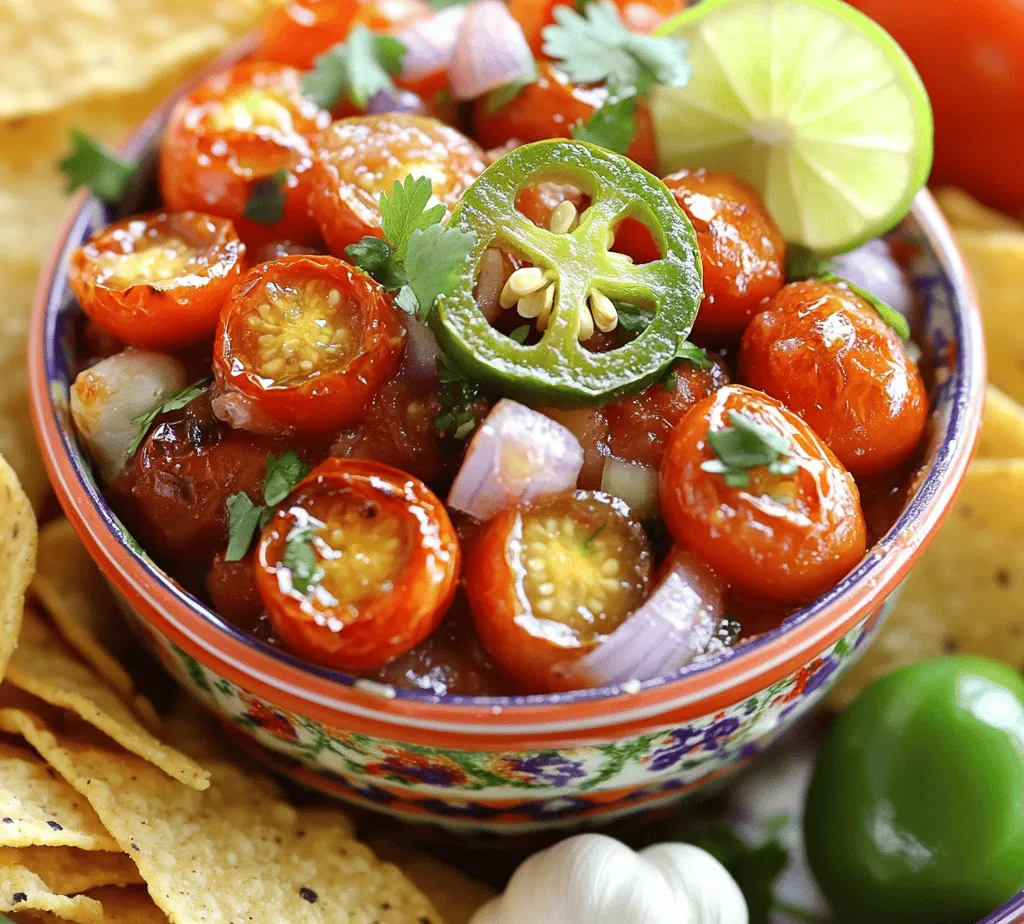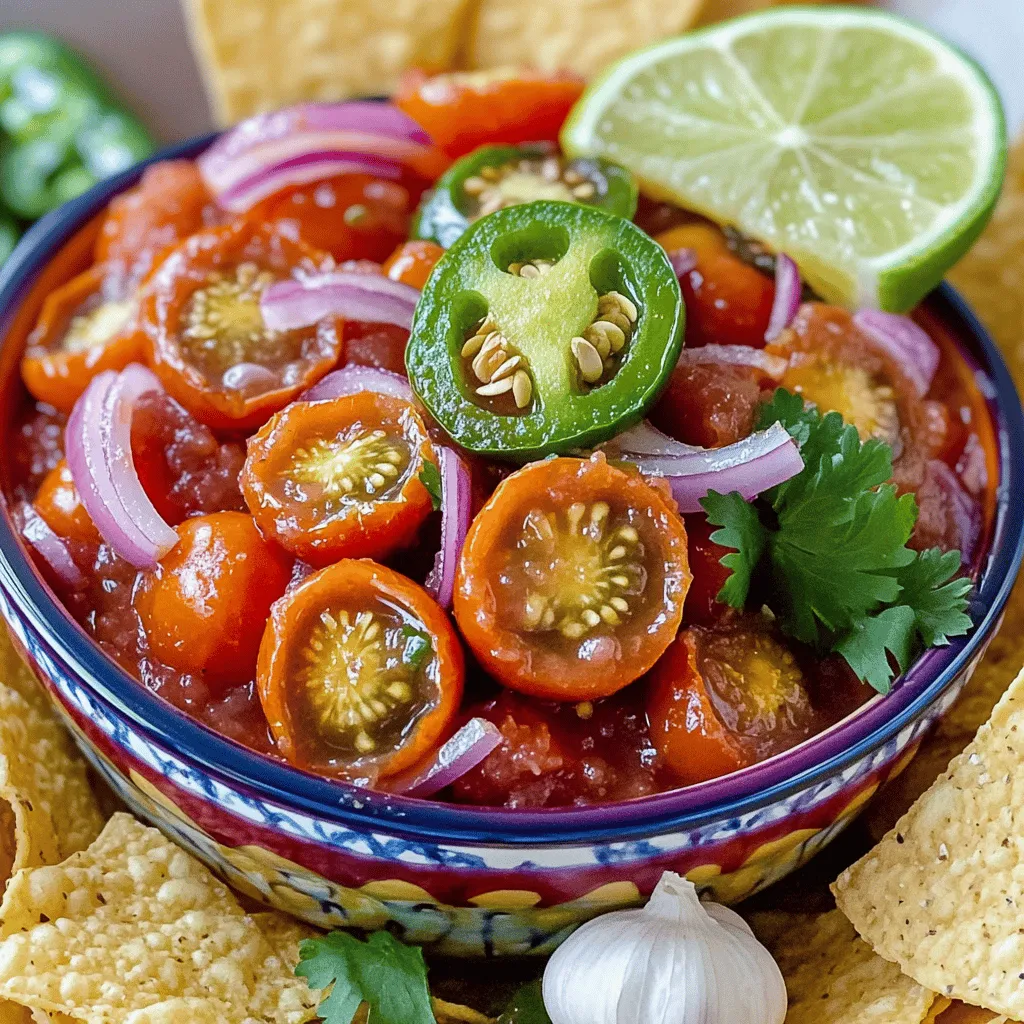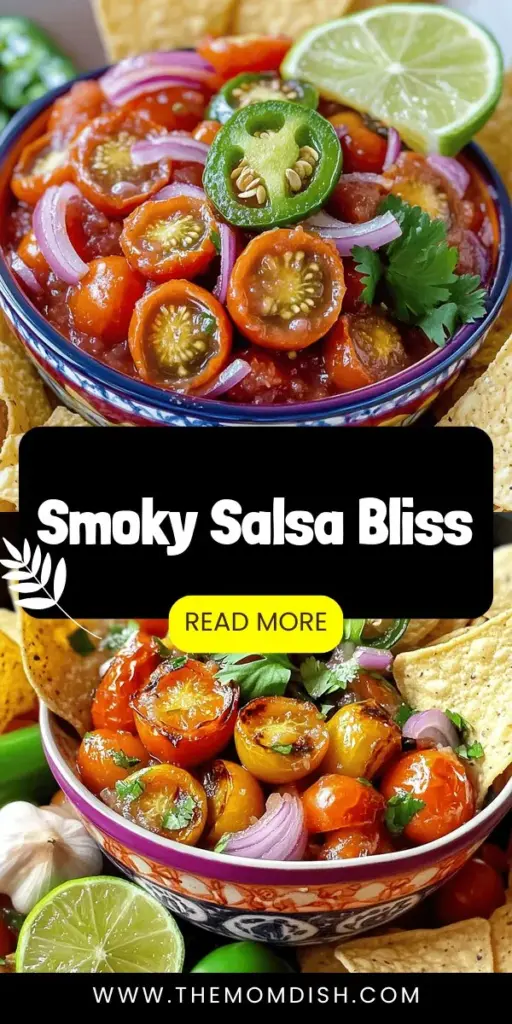Introduction
Salsa has long stood as a beloved staple in various cuisines, particularly within Mexican and Tex-Mex culinary traditions. This vibrant condiment, characterized by its zesty flavors and colorful presentation, has earned its place at the table, whether accompanying crispy tortilla chips, enhancing a taco, or lending its brightness to grilled meats. While traditional salsa recipes often rely on fresh, raw ingredients, there’s an exciting variation that takes this classic dip to a whole new level: smoky roasted salsa.
What sets smoky roasted salsa apart is its unique flavor profile, achieved through the roasting of key ingredients to bring out their natural sweetness and complexity. The charring process adds an irresistible smokiness that elevates the salsa from a simple dip to a flavor powerhouse, making it an excellent choice for gatherings or a personal indulgence. Homemade salsa offers unparalleled freshness and customization, allowing you to adjust the heat, acidity, and flavors to suit your palate, unlike many store-bought options that may contain preservatives or artificial flavors.
The key to creating a vibrant and delicious smoky roasted salsa lies in the quality and freshness of the ingredients. Using ripe tomatoes, aromatic onions, and fresh herbs not only enhances the overall flavor but also ensures that each bite is packed with freshness. In this article, we will delve into the essential ingredients, preparation techniques, and a step-by-step guide to making your own smoky roasted salsa at home.
Understanding the Ingredients
To create a truly exceptional smoky roasted salsa, it’s crucial to understand the role each ingredient plays in the final dish. Below, we’ll explore the primary components that contribute to the salsa’s robust flavor and texture.
Tomatoes
Tomatoes are the backbone of any salsa, providing a juicy base that balances the other flavors. For roasting, it’s best to select ripe tomatoes that are in season. Varieties such as Roma or vine-ripened tomatoes are ideal due to their meaty flesh and lower water content, which makes them perfect for roasting. The roasting process caramelizes their natural sugars, intensifying their flavor and adding a subtle sweetness to the salsa.
Onions
Onions contribute depth and sweetness to smoky roasted salsa. For this recipe, red onions are a fantastic choice due to their mild flavor and slight sweetness, which becomes even more pronounced when roasted. The caramelization that occurs during roasting adds complexity to the salsa, enhancing the overall taste experience.
Garlic
Garlic is another crucial ingredient that brings a punch of flavor to the salsa. Roasting garlic mellows its sharpness, creating a rich, buttery taste that complements the tomatoes and onions beautifully. Whole garlic cloves can be added to the roasting pan, allowing them to soften and sweeten as they cook.
Jalapeños
For those who enjoy a bit of heat, jalapeños are the perfect addition to smoky roasted salsa. These peppers can be roasted alongside the other ingredients to enhance their flavor and reduce their raw bite. Depending on your heat tolerance, you can adjust the number of jalapeños used, or even remove the seeds and membranes for a milder salsa.
Fresh Cilantro and Lime Juice
Fresh cilantro adds a burst of herbal brightness that balances the richness of the roasted ingredients, while lime juice contributes acidity that enhances the overall flavor profile. Together, they create a refreshing contrast that is essential for a well-rounded salsa.
Smoked Paprika
A key player in this recipe is smoked paprika, which adds an additional layer of smokiness that beautifully complements the roasted flavors. This spice, made from dried and smoked peppers, infuses the salsa with warmth and a hint of sweetness, enhancing the overall taste without overwhelming the other ingredients.
Olive Oil
Lastly, olive oil is a vital ingredient for roasting. Not only does it help to achieve a golden-brown color on the vegetables, but it also adds richness and depth of flavor. Additionally, olive oil is a healthier fat option, providing beneficial antioxidants and monounsaturated fats.
Preparation Techniques
Before diving into the step-by-step guide, let’s discuss the essential preparation techniques that will help you achieve the best results for your smoky roasted salsa.
Prepping the Ingredients
Selecting Ripe Tomatoes
When selecting tomatoes for your salsa, look for ones that are vibrant in color and slightly soft to the touch. Ripe tomatoes will have a sweet, fragrant aroma and should yield slightly when pressed. Avoid tomatoes that are overly firm or have blemishes, as these may not roast well.
Choosing the Right Red Onion
For smoky roasted salsa, opt for a medium-sized red onion that feels firm and has smooth skin. The sweetness of the red onion will balance the acidity of the tomatoes, enhancing the salsa’s overall flavor. If you’re looking for a more subtle onion flavor, you can also consider using sweet onions, such as Vidalia or Walla Walla.
Preparing Jalapeños
When preparing jalapeños for roasting, consider how much heat you want in your salsa. For a milder flavor, slice the jalapeños in half and remove the seeds and membranes, as these parts contain most of the heat. If you prefer a spicier salsa, you can roast them whole or leave some seeds intact.
The Importance of Roasting
Roasting is a crucial step in this recipe, as it enhances the flavors and textures of the ingredients. The high heat caramelizes the natural sugars in the tomatoes and onions, resulting in a richer taste. Meanwhile, blistering the tomatoes leads to a slightly charred exterior that adds depth to the salsa.
Understanding the science behind roasting can also help you achieve the best results. When tomatoes are exposed to high heat, their skins will blister and begin to separate from the flesh. This process not only adds a smoky flavor but also makes the tomatoes easier to blend into a smooth salsa. Similarly, caramelizing onions transforms their sharpness into a sweet, rich flavor that perfectly complements the other ingredients.
Equipment Needed
To make smoky roasted salsa, you’ll need a few essential kitchen tools to streamline the process:
– Baking Sheet: A large baking sheet is necessary for roasting the vegetables. Line it with parchment paper to prevent sticking and make cleanup easier.
– Blender or Food Processor: After roasting, you’ll need a blender or food processor to combine the ingredients into a smooth or chunky salsa, depending on your preference.
– Knife and Cutting Board: A sharp knife and a sturdy cutting board will make prepping the vegetables easier and safer.
Tips for Achieving the Best Results
– Preheat the Oven: Always preheat your oven to the desired temperature before roasting. This ensures that the ingredients cook evenly and develop a nice caramelization.
– Arrange Ingredients for Optimal Roasting: Spread the tomatoes, onions, garlic, and jalapeños evenly on the baking sheet, ensuring they are not overcrowded. This allows hot air to circulate around each piece, resulting in even cooking and optimal charring.
– Monitor the Roasting Time: Keep an eye on the ingredients as they roast, as cooking times can vary based on their size and your oven. You want them to be nicely charred but not burnt.
Step-by-Step Guide to Making Smoky Roasted Salsa
Now that you have a solid understanding of the ingredients and preparation techniques, let’s dive into the step-by-step process of making smoky roasted salsa.
Preheating the Oven
Start by preheating your oven to 425°F (220°C). This high temperature is essential for roasting the vegetables quickly and effectively, allowing them to achieve that perfect smoky flavor.
Arranging Ingredients for Optimal Roasting
Once your oven is preheated, it’s time to prepare the ingredients for roasting. On your lined baking sheet, arrange the ripe tomatoes, sliced red onion, whole garlic cloves, and halved jalapeños. Make sure to spread them out in a single layer, allowing space between each piece for even cooking.
The positioning of your ingredients matters. Place the tomatoes cut-side up to maximize their exposure to the heat, while the onions and jalapeños can be scattered around them. This arrangement not only ensures even roasting but also creates an aesthetically pleasing presentation.
Once everything is arranged, drizzle a generous amount of olive oil over the vegetables, ensuring they are well-coated. Season with salt and freshly cracked black pepper to enhance the flavors, and toss gently to combine.
With the oven preheated and your ingredients arranged, you are ready to roast them to perfection.
In the next part of the article, we will continue with detailed instructions on roasting the ingredients, blending them into a delicious salsa, and additional tips to customize your smoky roasted salsa to your liking. Stay tuned for a culinary adventure that will elevate your salsa game!

Timing for Each Ingredient to Ensure Perfect Doneness
To create a smoky roasted salsa that boasts depth and flavor, timing is crucial for each ingredient. Start by preheating your oven to 425°F (220°C). The roasting process enhances the natural sweetness of the vegetables, giving the salsa a robust flavor profile.
1. Tomatoes: Roast the tomatoes for about 25-30 minutes. They should be nicely charred and softened, releasing their juices and intensifying their sweetness. Choose ripe, firm tomatoes for the best results.
2. Onions: Cut the onions into wedges and roast them alongside the tomatoes. They typically take about 20-25 minutes to caramelize properly. Aim for a golden-brown color to achieve that sweet, smoky flavor.
3. Peppers: If you’re using bell peppers, roast them for approximately 20-25 minutes until they are tender and have char marks. For a spicier kick, consider the timing for jalapeños or serranos, which can be roasted for about 15-20 minutes depending on their size and desired smokiness.
4. Garlic: Garlic cloves can be roasted for around 10-15 minutes. You want them soft and slightly golden, which brings out their natural sweetness without burning.
5. Lime: If you choose to roast lime for added flavor, place halved limes in the oven for about 10 minutes until they are warm and aromatic, enhancing their juice’s brightness when squeezed into the salsa.
Blending the Salsa
Once your ingredients are perfectly roasted, it’s time to blend them into a salsa. The blending process is crucial for achieving the desired consistency, whether you prefer a chunky or smooth texture.
– Chunky Salsa: For a chunky texture, pulse the roasted ingredients in a food processor or blender just a few times. This method allows for larger pieces to remain, providing a delightful textural contrast. Make sure not to over-blend; you want to retain some of the character of the vegetables.
– Smooth Salsa: If you prefer a smoother salsa, blend the ingredients longer. Add a bit of the reserved juice from the roasted tomatoes to help achieve the desired consistency. You can also drizzle in olive oil for a silkier finish.
Flavor Balancing: Tasting and Adjusting Seasoning
As with any great salsa, flavor balance is essential. After blending, taste your salsa and adjust the seasoning accordingly. Here are some tips to balance the flavors effectively:
– Salt: Start with a pinch of salt and add more as needed. Salt enhances all the flavors and helps to brighten the salsa.
– Acidity: A squeeze of fresh lime juice can elevate the entire dish, adding brightness and cutting through the richness of the roasted vegetables. Adjust the acidity to your liking.
– Sweetness: If the salsa tastes too acidic or bitter, a touch of honey or agave syrup can help round out the flavors.
– Heat: If you want more heat, consider adding a dash of cayenne pepper or more roasted peppers to the mix. Always taste before adding more spice.
Serving Suggestions
When it comes to serving your smoky roasted salsa, presentation can elevate the experience and make your dish more enticing. Here are some ideas to enhance the visual appeal and enjoyment of your salsa:
Presentation Ideas for a Festive Touch
– Serving Bowl: Choose a vibrant, decorative bowl that complements the colors of the salsa. A handmade ceramic bowl can add rustic charm, while a glass bowl can showcase the salsa’s bright hues.
– Garnishing Options: Fresh garnishes can elevate the presentation. Consider topping your salsa with a few sprigs of cilantro or slices of lime. This not only looks appealing but adds freshness to each serving.
Pairing the Salsa
The versatility of smoky roasted salsa means it can accompany a wide variety of dishes. Here are some recommended pairings:
– Tortilla Chips: The classic pairing for salsa, tortilla chips provide a crunchy contrast to the smoothness of the salsa. Offer a variety of chips, such as blue corn or multigrain, for added flavor and texture.
– Grilled Meats: Use the salsa as a condiment for grilled meats, such as chicken, steak, or fish. The smoky flavors will complement the charred taste of the grilled proteins.
– Tacos: Add a generous spoonful of salsa to tacos for an extra burst of flavor. It’s perfect with carne asada, grilled shrimp, or even vegetarian tacos.
– Creative Uses in Recipes: Think outside the box! Use the smoky roasted salsa as a topping for breakfast eggs, mix it into salads for an added zing, or use it as a marinade for meats or vegetables before grilling.
Nutritional Benefits of Smoky Roasted Salsa
One of the best aspects of smoky roasted salsa is its health benefits. Made primarily from fresh ingredients, this salsa is low in calories and high in nutrients.
– Health Benefits of Fresh Ingredients: Tomatoes are rich in vitamins C and K, as well as antioxidants like lycopene, which has been linked to many health benefits. Onions and garlic contain compounds that may help reduce inflammation and improve heart health.
– Low-Calorie and Nutrient-Dense Nature of Salsa: This salsa is a great way to add flavor without significant calories. A serving of salsa contains minimal fat and sugar while packing a punch of flavor and nutrients.
– Incorporating Salsa into a Balanced Diet: Adding salsa to meals can enhance flavor while keeping your diet balanced. Use it as a dip, condiment, or ingredient to increase vegetable intake and add excitement to your meals.
Variations and Customizations
One of the joys of making your own smoky roasted salsa is the ability to customize it to suit your taste preferences.
Adjusting the Heat Level
If you’re looking for a salsa that fits your heat tolerance, here are some adjustments you can make:
– Mild Version: Use sweet bell peppers and eliminate any hot peppers. You can also add a bit of sugar to balance the flavors without the heat.
– Medium Version: Incorporate jalapeños, removing the seeds to reduce heat. This will provide a pleasant kick while still being approachable.
– Hot Version: For those who love heat, use serrano or habanero peppers. Be cautious with the quantities; you can always add more but can’t take it out once blended.
Additional Ingredients to Enhance Flavor
Consider experimenting with different ingredients to elevate your salsa further:
– Fruits: Adding fruits like diced mango or pineapple can introduce a sweet contrast to the smoky flavors. Roast them alongside the other vegetables for a caramelized taste.
– Spices: Incorporating spices like cumin or coriander can deepen the flavor profile. Start with a pinch and adjust according to your taste. These spices work harmoniously with the roasted elements.
Conclusion
Smoky roasted salsa is a delightful and versatile addition to any meal, bursting with flavor and health benefits. Whether you enjoy it as a dip, topping, or as part of a more complex dish, this salsa can be adapted to fit any taste preference.
As you explore the variations and customizations available, don’t hesitate to make it your own. Experiment with different ingredients, adjust the heat to your liking, and have fun in the kitchen.
The joy of creating homemade salsa lies not only in the final product but also in the process of experimenting and sharing it with loved ones. So gather your ingredients, fire up your oven, and enjoy the smoky, delicious flavors that come from your very own kitchen.



